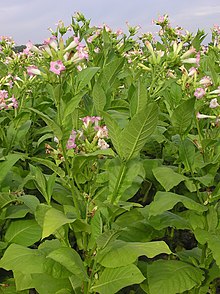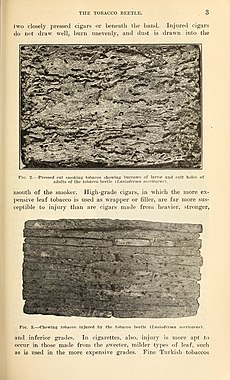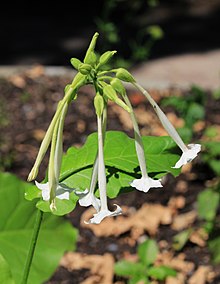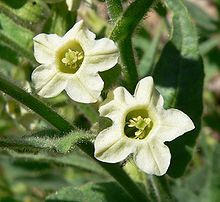Nicotiana: Difference between revisions
Plantsurfer (talk | contribs) use the verb, not the adjective |
Added further informations with 1 academic, reliable reference (Ryan, L., ed. (1995): "Introduction", in "Post-harvest Tobacco Infestation Control", pages 1–4. Norwell, Massachusetts and Dordrecht, Netherlands: Kluwer Academic Publishers. DOI: 10.1007/978-94-017-2723-5_1. ISBN: 978-94-017-2723-5). |
||
| Line 26: | Line 26: | ||
|}} |
|}} |
||
'''''Nicotiana''''' ({{IPAc-en|ˌ|n|ɪ|k|oʊ|ʃ|i|ˈ|eɪ|n|ə|,_|n|ɪ|ˌ|k|oʊ|-|,_|-|k|ɒ|t|i|-|,_|-|ˈ|ɑː|n|ə|,_|-|ˈ|æ|n|ə}}{{refn|{{OxfordDictionaries.com|access-date=2016-01-21|Nicotiana}}}}{{refn|{{MerriamWebsterDictionary|access-date=2016-01-21|Nicotiana}}}}<ref>''Sunset Western Garden Book,'' 1995:606–607</ref>) is a [[genus]] of [[herbaceous plants]] and [[shrub]]s in the [[ |
'''''Nicotiana''''' ({{IPAc-en|ˌ|n|ɪ|k|oʊ|ʃ|i|ˈ|eɪ|n|ə|,_|n|ɪ|ˌ|k|oʊ|-|,_|-|k|ɒ|t|i|-|,_|-|ˈ|ɑː|n|ə|,_|-|ˈ|æ|n|ə}}{{refn|{{OxfordDictionaries.com|access-date=2016-01-21|Nicotiana}}}}{{refn|{{MerriamWebsterDictionary|access-date=2016-01-21|Nicotiana}}}}<ref>''Sunset Western Garden Book,'' 1995:606–607</ref>) is a [[genus]] of [[herbaceous plants]] and [[shrub]]s in the [[Family (biology)|family]] [[Solanaceae]], that is [[Native plant|indigenous]] to the Americas, Australia, Southwestern Africa and the South Pacific. Various ''Nicotiana'' [[species]], commonly referred to as '''tobacco plants''', are cultivated as ornamental garden plants. ''[[Nicotiana tabacum|N. tabacum]]'' is grown worldwide for the cultivation of [[tobacco leaves]] used for manufacturing and producing [[List of tobacco products|tobacco products]], including [[cigar]]s, [[cigarillo]]s, and [[cigarette]]s. |
||
| ⚫ | |||
== |
==Taxonomy== |
||
=== |
===Species=== |
||
{{main|List of Nicotiana species{{!}}List of ''Nicotiana'' species}} |
{{main|List of Nicotiana species{{!}}List of ''Nicotiana'' species}} |
||
| ⚫ | |||
The 67 species include:<ref name=FG>{{Cite web|url=https://www.finegardening.com/genus/nicotiana|title=Nicotiana|access-date=May 26, 2020}}</ref><ref>{{Cite web|url=http://www.theplantlist.org/tpl1.1/search?q=Nicotiana|title=Search results — The Plant List|website=www.theplantlist.org|access-date=May 26, 2020}}</ref> |
The 67 species include:<ref name=FG>{{Cite web|url=https://www.finegardening.com/genus/nicotiana|title=Nicotiana|access-date=May 26, 2020}}</ref><ref>{{Cite web|url=http://www.theplantlist.org/tpl1.1/search?q=Nicotiana|title=Search results — The Plant List|website=www.theplantlist.org|access-date=May 26, 2020}}</ref> |
||
| Line 69: | Line 69: | ||
The word ''nicotiana'' (as well as ''[[nicotine]]'') was named in honor of [[Jean Nicot]], French ambassador to Portugal, who in 1559 sent it as a medicine to the court of Catherine de' Medici.<ref>{{cite web |url=http://www.tc.columbia.edu/centers/cifas/drugsandsociety/background/chronologydruguse.html |title=Chronology of Psychoactive Substance Use |first=Gregory |last=Austin |website=Teachers College Columbia University |archive-url=https://web.archive.org/web/20110809165620/http://www.tc.columbia.edu/centers/cifas/drugsandsociety/background/chronologydruguse.html |archive-date=2011-08-09 |access-date=2014-02-08}}</ref> |
The word ''nicotiana'' (as well as ''[[nicotine]]'') was named in honor of [[Jean Nicot]], French ambassador to Portugal, who in 1559 sent it as a medicine to the court of Catherine de' Medici.<ref>{{cite web |url=http://www.tc.columbia.edu/centers/cifas/drugsandsociety/background/chronologydruguse.html |title=Chronology of Psychoactive Substance Use |first=Gregory |last=Austin |website=Teachers College Columbia University |archive-url=https://web.archive.org/web/20110809165620/http://www.tc.columbia.edu/centers/cifas/drugsandsociety/background/chronologydruguse.html |archive-date=2011-08-09 |access-date=2014-02-08}}</ref> |
||
== |
==Ecology== |
||
| ⚫ | |||
| ⚫ | |||
[[File:The tobacco beetle (Page 3) BHL41830187.jpg|thumb|right|230px|Illustration with photographs of [[tobacco leaves]] infested by ''[[Lasioderma serricorne]]'' (tobacco beetles), from Runner, G. A., ''The tobacco beetle'' (1919), Bulletin of the U.S. Department of Agriculture, [[Biodiversity Heritage Library]]]] |
|||
| ⚫ | |||
| ⚫ | Despite containing enough [[nicotine]] and/or other compounds such as [[germacrene]] and [[anabasine]] and other [[piperidine]] [[alkaloid]]s (varying between species) to [[Plant defense against herbivory|deter]] most [[herbivore]]s,<ref>{{cite journal |last=Panter |first=KE |last2=Keeler |first2=RF |last3=Bunch |first3=TD |last4=Callan |first4=RJ |year=1990 |title=Congenital skeletal malformations and cleft palate induced in goats by ingestion of ''Lupinus'', ''Conium'' and ''Nicotiana'' species |journal=Toxicon |pages=1377–1385 |volume=28 |issue=12 |pmid=2089736|doi=10.1016/0041-0101(90)90154-Y }}</ref> a number of such animals have [[Evolution|evolved]] the ability to feed on ''Nicotiana'' species without being harmed. Nonetheless, tobacco is unpalatable to many species and therefore some tobacco plants (chiefly tree tobacco, ''[[Nicotiana glauca|N. glauca]]'') have become established as [[invasive species]] in some places. |
||
| ⚫ | |||
| ⚫ | Despite containing enough [[nicotine]] and/or other compounds such as [[germacrene]] and [[anabasine]] and other [[piperidine]] [[alkaloid]]s (varying between species) to [[Plant defense against herbivory|deter]] most [[herbivore]]s,<ref>{{cite journal |last=Panter |first=KE |last2=Keeler |first2=RF |last3=Bunch |first3=TD |last4=Callan |first4=RJ |year=1990 |title=Congenital skeletal malformations and cleft palate induced in goats by ingestion of ''Lupinus'', ''Conium'' and ''Nicotiana'' species |journal=Toxicon |pages=1377–1385 |volume=28 |issue=12 |pmid=2089736|doi=10.1016/0041-0101(90)90154-Y }}</ref> a number of such animals have [[ |
||
In the 19th century, young tobacco plantings came under increasing attack from [[flea beetle]]s (''[[Epitrix cucumeris]]'' and/or ''[[Epitrix pubescens]]''), causing destruction of half the United States tobacco crop in 1876. In the years afterward, many experiments were attempted and discussed to control the flea beetle. By 1880, it was discovered that covering young plants with a frame covered with thin fabric (instead of with branches, as had previously been used for frost control) would effectively protect plants from the beetle. This practice spread until it became ubiquitous in the 1890s.{{citation needed|date=June 2021}} |
In the 19th century, young tobacco plantings came under increasing attack from [[flea beetle]]s (''[[Epitrix cucumeris]]'' and/or ''[[Epitrix pubescens]]''), causing destruction of half the United States tobacco crop in 1876. In the years afterward, many experiments were attempted and discussed to control the flea beetle. By 1880, it was discovered that covering young plants with a frame covered with thin fabric (instead of with branches, as had previously been used for frost control) would effectively protect plants from the beetle. This practice spread until it became ubiquitous in the 1890s.{{citation needed|date=June 2021}} |
||
Tobacco, alongside its [[List of tobacco products|related products]], can be infested by [[Parasitism|parasites]] such as the ''[[Lasioderma serricorne]]'' (tobacco beetle) and the ''[[Ephestia elutella]]'' (tobacco moth), which are the most widespread and damaging parasites to the [[tobacco industry]].<ref name="Ryan 1995">{{cite book |editor-last=Ryan |editor-first=L. |year=1995 |chapter=Introduction |chapter-url=https://books.google.com/books?id=QzUAI2vK3XMC&pg=PA1 |title=Post-harvest Tobacco Infestation Control |location=[[Norwell, Massachusetts]] and [[Dordrecht]], [[Netherlands]] |publisher=[[Kluwer Academic Publishers]] |pages=1–4 |doi=10.1007/978-94-017-2723-5_1 |isbn=978-94-017-2723-5}}</ref> Infestation can range from the tobacco cultivated in the fields to the [[Tobacco leaves|leaves]] used for manufacturing [[cigar]]s, [[cigarillo]]s, [[cigarette]]s, etc.<ref name="Ryan 1995"/> Both the [[larvae]] of ''Lasioderma serricorne'' and [[caterpillar]]s of ''Ephestia elutella'' are considered a [[Pest (organism)|pest]].<ref name="Ryan 1995"/> |
|||
[[Lepidoptera]] whose [[caterpillar]]s feed on ''Nicotiana'' include: |
[[Lepidoptera]] whose [[caterpillar]]s feed on ''Nicotiana'' include: |
||
* [[Dark sword-grass]] or black cutworm, ''Agrotis ipsilon'' |
* [[Dark sword-grass]] or black cutworm, ''Agrotis ipsilon'' |
||
* [[Turnip moth]], ''Agrotis segetum'' |
* [[Turnip moth]], ''Agrotis segetum'' |
||
| Line 98: | Line 99: | ||
* ''[[Rhectocraspeda periusalis]]''<ref name=Hayden-eal-2013/> |
* ''[[Rhectocraspeda periusalis]]''<ref name=Hayden-eal-2013/> |
||
These are mainly [[Noctuidae]], but they also comprise [[Sphingidae]], [[Gelechiidae]] and [[Crambidae]]. |
These are mainly [[Noctuidae]], but they also comprise [[Sphingidae]], [[Gelechiidae]], and [[Crambidae]]. |
||
[[File:Nicotiana sylvestris Prague 2013 3.jpg|thumb|''[[Nicotiana sylvestris]]'']] |
[[File:Nicotiana sylvestris Prague 2013 3.jpg|thumb|''[[Nicotiana sylvestris]]'']] |
||
| Line 106: | Line 107: | ||
[[File:Nicotinana alata0.jpg|thumb|right|[[Nicotiana × sanderae|''Nicotiana'' × ''sanderae'']] ornamental cultivar]] |
[[File:Nicotinana alata0.jpg|thumb|right|[[Nicotiana × sanderae|''Nicotiana'' × ''sanderae'']] ornamental cultivar]] |
||
== |
==Cultivation== |
||
Several species of ''Nicotiana'', such as ''N. sylvestris'',<ref>{{Cite web|url=https://www.rhs.org.uk/plants/search-results?form-mode=false&query=Nicotiana+sylvestris|title=RHS advice & tips on garden & indoor plants | Plant finder & selector / RHS Gardening|website=www.rhs.org.uk|access-date=May 26, 2020}}</ref> ''N. alata'' 'Lime Green'<ref>{{Cite web|url=https://www.finegardening.com/plant/flowering-tobacco-nicotiana-alata-lime-green|title='Lime Green' flowering tobacco|access-date=May 26, 2020}}</ref><ref name=rhsnicalat/> and ''N. langsdorffii'' are grown as [[ornamental plant]]s, often under the name of flowering tobacco.<ref name=FG/><ref name=NGB>{{Cite web |url=http://www.northerngardening.com/NGB_articles/nicotiana.htm |title=The National Garden Bureau |access-date=2014-07-23 |archive-url=https://web.archive.org/web/20150421084521/http://www.northerngardening.com/NGB_articles/nicotiana.htm |archive-date=2015-04-21 |url-status=dead }}</ref> They are popular [[vespertine (biology)|vespertines]] (evening bloomers), their sweet-smelling flowers opening in the evening to be visited by [[Sphingidae|hawkmoths]] and other [[pollinator]]s. In temperate climates they behave as [[Annual plants|annuals]] ([[Hardiness (plants)|hardiness]] 9a-11).<ref>{{Cite web|url=https://davesgarden.com/guides/pf/go/1175/|title=PlantFiles: Nicotiana Species, Flowering Tobacco|website=Dave's Garden|access-date=May 26, 2020}}</ref> |
Several species of ''Nicotiana'', such as ''N. sylvestris'',<ref>{{Cite web|url=https://www.rhs.org.uk/plants/search-results?form-mode=false&query=Nicotiana+sylvestris|title=RHS advice & tips on garden & indoor plants | Plant finder & selector / RHS Gardening|website=www.rhs.org.uk|access-date=May 26, 2020}}</ref> ''N. alata'' 'Lime Green'<ref>{{Cite web|url=https://www.finegardening.com/plant/flowering-tobacco-nicotiana-alata-lime-green|title='Lime Green' flowering tobacco|access-date=May 26, 2020}}</ref><ref name=rhsnicalat/> and ''N. langsdorffii'' are grown as [[ornamental plant]]s, often under the name of flowering tobacco.<ref name=FG/><ref name=NGB>{{Cite web |url=http://www.northerngardening.com/NGB_articles/nicotiana.htm |title=The National Garden Bureau |access-date=2014-07-23 |archive-url=https://web.archive.org/web/20150421084521/http://www.northerngardening.com/NGB_articles/nicotiana.htm |archive-date=2015-04-21 |url-status=dead }}</ref> They are popular [[vespertine (biology)|vespertines]] (evening bloomers), their sweet-smelling flowers opening in the evening to be visited by [[Sphingidae|hawkmoths]] and other [[pollinator]]s. In temperate climates they behave as [[Annual plants|annuals]] ([[Hardiness (plants)|hardiness]] 9a-11).<ref>{{Cite web|url=https://davesgarden.com/guides/pf/go/1175/|title=PlantFiles: Nicotiana Species, Flowering Tobacco|website=Dave's Garden|access-date=May 26, 2020}}</ref> |
||
The [[hybrid plant|hybrid]] [[cultivar]] <!-- AGM withdrawn Domino Series <ref>{{cite web |url=http://apps.rhs.org.uk/plantselector/plant?plantid=1329 |title=''Nicotiana'' Domino Series |website=RHS Gardening |access-date=July 23, 2014}}</ref>-->'Lime Green'<ref name=rhsnicalat>{{cite web |url=https://www.rhs.org.uk/Plants/106193/Nicotiana-Lime-Green/Details |title=Nicotiana 'Lime Green' |website=RHS Gardening |access-date=18 January 2021}}</ref> has gained the [[Royal Horticultural Society]]'s [[Award of Garden Merit]].<ref>{{cite web | url= https://www.rhs.org.uk/plants/pdfs/agm-lists/agm-ornamentals.pdf | title = AGM Plants - Ornamental | date = July 2017 | page = 69 | publisher = Royal Horticultural Society | access-date = 13 April 2018}}</ref> |
The [[hybrid plant|hybrid]] [[cultivar]] <!-- AGM withdrawn Domino Series <ref>{{cite web |url=http://apps.rhs.org.uk/plantselector/plant?plantid=1329 |title=''Nicotiana'' Domino Series |website=RHS Gardening |access-date=July 23, 2014}}</ref>-->'Lime Green'<ref name=rhsnicalat>{{cite web |url=https://www.rhs.org.uk/Plants/106193/Nicotiana-Lime-Green/Details |title=Nicotiana 'Lime Green' |website=RHS Gardening |access-date=18 January 2021}}</ref> has gained the [[Royal Horticultural Society]]'s [[Award of Garden Merit]].<ref>{{cite web | url= https://www.rhs.org.uk/plants/pdfs/agm-lists/agm-ornamentals.pdf | title = AGM Plants - Ornamental | date = July 2017 | page = 69 | publisher = Royal Horticultural Society | access-date = 13 April 2018}}</ref> |
||
| Line 115: | Line 116: | ||
{{Tobacco}} |
{{Tobacco}} |
||
== |
==References== |
||
{{Reflist|3}} |
{{Reflist|3}} |
||
== |
==Bibliography== |
||
{{refbegin}} |
{{refbegin}} |
||
* {{aut|[[Integrated Taxonomic Information System]] (ITIS)}} (1999): [https://www.itis.gov/servlet/SingleRpt/SingleRpt?search_topic=TSN&search_value=30562 ''Nicotiana'']. Retrieved 2007-11-20. |
* {{aut|[[Integrated Taxonomic Information System]] (ITIS)}} (1999): [https://www.itis.gov/servlet/SingleRpt/SingleRpt?search_topic=TSN&search_value=30562 ''Nicotiana'']. Retrieved 2007-11-20. |
||
| Line 125: | Line 126: | ||
{{refend}} |
{{refend}} |
||
== |
==External links== |
||
*[http://www.theplantlist.org/tpl1.1/search?q=Nicotiana The Plant List] |
*[http://www.theplantlist.org/tpl1.1/search?q=Nicotiana The Plant List] |
||
| Line 134: | Line 135: | ||
{{Authority control}} |
{{Authority control}} |
||
[[Category:Nicotiana| ]] |
[[Category:Nicotiana| ]] |
||
| ⚫ | |||
[[Category:Entheogens]] |
[[Category:Entheogens]] |
||
[[Category:Solanaceae genera]] |
[[Category:Solanaceae genera]] |
||
| ⚫ | |||
[[az:Tütün]] |
[[az:Tütün]] |
||
Revision as of 11:01, 20 March 2022
| Nicotiana | |
|---|---|

| |
| Nicotiana tabacum | |
| Scientific classification | |
| Kingdom: | Plantae |
| Clade: | Tracheophytes |
| Clade: | Angiosperms |
| Clade: | Eudicots |
| Clade: | Asterids |
| Order: | Solanales |
| Family: | Solanaceae |
| Tribe: | Nicotianeae |
| Genus: | Nicotiana L. |
| Type species | |
| Nicotiana tabacum L.
| |
| Species | |
|
See text | |
| Synonyms | |
|
Amphipleis Raf. | |
Nicotiana (/ˌnɪkoʊʃiˈeɪnə, nɪˌkoʊ-, -kɒti-, -ˈɑːnə, -ˈænə/[2][3][4]) is a genus of herbaceous plants and shrubs in the family Solanaceae, that is indigenous to the Americas, Australia, Southwestern Africa and the South Pacific. Various Nicotiana species, commonly referred to as tobacco plants, are cultivated as ornamental garden plants. N. tabacum is grown worldwide for the cultivation of tobacco leaves used for manufacturing and producing tobacco products, including cigars, cigarillos, and cigarettes.
Taxonomy
Species

- Nicotiana acuminata (Graham) Hook. – manyflower tobacco[7]
- Nicotiana africana Merxm.[7]
- Nicotiana alata Link & Otto – winged tobacco, jasmine tobacco, tanbaku (Persian)[7]
- Nicotiana attenuata Torrey ex S. Watson – coyote tobacco[7]
- Nicotiana benthamiana Domin[7] – benth or benthi
- Nicotiana clevelandii A. Gray[7] – Cleveland's tobacco
- Nicotiana glauca Graham – tree tobacco, Brazilian tree tobacco, shrub tobacco, mustard tree[7]
- Nicotiana glutinosa L.
- Nicotiana langsdorffii Weinm.[7] – Langsdorff's tobacco
- Nicotiana longiflora Cav.[7] – longflower tobacco or long-flowered tobacco
- Nicotiana occidentalis H.-M. Wheeler[7] – native tobacco
- Nicotiana obtusifolia M. Martens & Galeotti – desert tobacco, punche, "tabaquillo"[7]
- Nicotiana otophora Griseb.[7]
- Nicotiana plumbaginifolia Viv. – Tex-Mex tobacco
- Nicotiana quadrivalvis Pursh – Indian tobacco
- Nicotiana rustica L. – Aztec tobacco, mapacho[7]
- Nicotiana suaveolens Lehm. – Australian tobacco[7]
- Nicotiana sylvestris Speg. & Comes – South American tobacco, woodland tobacco[7]
- Nicotiana tabacum L. – commercial tobacco grown for the production of cigarettes, cigars, chewing tobacco, etc.[7]
- Nicotiana tomentosiformis Goodsp.[7]
Manmade hybrids
- Nicotiana × didepta N. debneyi × N. tabacum[8]
- Nicotiana × digluta N. glutinosa × N. tabacum[9]
- Nicotiana × sanderae Hort. ex Wats. N. alata × N. forgetiana[8]
Formerly placed here
- Petunia axillaris (Lam.) Britton et al. (as N. axillaris Lam.)[10]
Etymology
The word nicotiana (as well as nicotine) was named in honor of Jean Nicot, French ambassador to Portugal, who in 1559 sent it as a medicine to the court of Catherine de' Medici.[11]
Ecology


Despite containing enough nicotine and/or other compounds such as germacrene and anabasine and other piperidine alkaloids (varying between species) to deter most herbivores,[12] a number of such animals have evolved the ability to feed on Nicotiana species without being harmed. Nonetheless, tobacco is unpalatable to many species and therefore some tobacco plants (chiefly tree tobacco, N. glauca) have become established as invasive species in some places.
In the 19th century, young tobacco plantings came under increasing attack from flea beetles (Epitrix cucumeris and/or Epitrix pubescens), causing destruction of half the United States tobacco crop in 1876. In the years afterward, many experiments were attempted and discussed to control the flea beetle. By 1880, it was discovered that covering young plants with a frame covered with thin fabric (instead of with branches, as had previously been used for frost control) would effectively protect plants from the beetle. This practice spread until it became ubiquitous in the 1890s.[citation needed]
Tobacco, alongside its related products, can be infested by parasites such as the Lasioderma serricorne (tobacco beetle) and the Ephestia elutella (tobacco moth), which are the most widespread and damaging parasites to the tobacco industry.[13] Infestation can range from the tobacco cultivated in the fields to the leaves used for manufacturing cigars, cigarillos, cigarettes, etc.[13] Both the larvae of Lasioderma serricorne and caterpillars of Ephestia elutella are considered a pest.[13]
Lepidoptera whose caterpillars feed on Nicotiana include:
- Dark sword-grass or black cutworm, Agrotis ipsilon
- Turnip moth, Agrotis segetum
- Mouse moth, Amphipyra tragopoginis
- The nutmeg, Discestra trifolii
- Endoclita excrescens
- Blackburn's sphinx moth, Manduca blackburni
- Tobacco hornworm, Manduca sexta
- Tomato hornworm, Manduca quinquemaculata
- Cabbage moth, Mamestra brassicae
- Angle shades, Phlogophora meticulosa
- Setaceous Hebrew character, Xestia c-nigrum
- Cabbage looper, Trichoplusia ni[14]
- Fall armyworm
- Phthorimaea operculella[15]
- Tuta absoluta[15]
- Lineodes integra[15]
- Rhectocraspeda periusalis[15]
These are mainly Noctuidae, but they also comprise Sphingidae, Gelechiidae, and Crambidae.





Cultivation
Several species of Nicotiana, such as N. sylvestris,[16] N. alata 'Lime Green'[17][18] and N. langsdorffii are grown as ornamental plants, often under the name of flowering tobacco.[5][19] They are popular vespertines (evening bloomers), their sweet-smelling flowers opening in the evening to be visited by hawkmoths and other pollinators. In temperate climates they behave as annuals (hardiness 9a-11).[20] The hybrid cultivar 'Lime Green'[18] has gained the Royal Horticultural Society's Award of Garden Merit.[21]
Garden varieties are derived from N. alata (e.g. 'Niki' and 'Saratoga' series) and more recently from Nicotiana x sanderae (e.g. 'Perfume' and 'Domino' series).[19]
The tobacco budworm (Heliothis virescens) has proved to be a massive “pest” of many species in the genus, and has resisted many attempts at management.[22]
| Part of a series on |
| Tobacco |
|---|
 |
References
- ^ "Nicotiana L." Germplasm Resources Information Network. United States Department of Agriculture. 2006-04-13. Archived from the original on 2010-08-20. Retrieved 2010-06-03.
- ^ "Nicotiana". Oxford Dictionaries UK English Dictionary. Oxford University Press. n.d. Retrieved 2016-01-21.
- ^ "Nicotiana". Merriam-Webster.com Dictionary. Retrieved 2016-01-21.
- ^ Sunset Western Garden Book, 1995:606–607
- ^ a b "Nicotiana". Retrieved May 26, 2020.
- ^ "Search results — The Plant List". www.theplantlist.org. Retrieved May 26, 2020.
- ^ a b c d e f g h i j k l m n o p q Knapp et al. (2004) Nomenclatural changes and a new sectional classification in Nicotiana (Solanaceae) Taxon. 53(1):73-82.
- ^ a b Bot, Ann (2003). "Molecular Systematics, GISH and the Origin of Hybrid Taxa in Nicotiana (Solanaceae)". Annals of Botany. 92 (1): 107–127. doi:10.1093/aob/mcg087. PMC 4243627. PMID 12824072.
- ^ Clausen, R.E. (1928) Interspecific hybridization in Nicotiana. VII. The cytology of hybrids of the synthetic species, digluta, with its parents, glutinosa and tabacum. Univ. Cal. Pub. Botany. 11(10):177-211.
- ^ "GRIN Species Records of Nicotiana". United States Department of Agriculture. Retrieved 2010-11-30.
{{cite journal}}: Cite journal requires|journal=(help) - ^ Austin, Gregory. "Chronology of Psychoactive Substance Use". Teachers College Columbia University. Archived from the original on 2011-08-09. Retrieved 2014-02-08.
- ^ Panter, KE; Keeler, RF; Bunch, TD; Callan, RJ (1990). "Congenital skeletal malformations and cleft palate induced in goats by ingestion of Lupinus, Conium and Nicotiana species". Toxicon. 28 (12): 1377–1385. doi:10.1016/0041-0101(90)90154-Y. PMID 2089736.
- ^ a b c Ryan, L., ed. (1995). "Introduction". Post-harvest Tobacco Infestation Control. Norwell, Massachusetts and Dordrecht, Netherlands: Kluwer Academic Publishers. pp. 1–4. doi:10.1007/978-94-017-2723-5_1. ISBN 978-94-017-2723-5.
- ^ United States. Agricultural Research Service (1984), Suppression and Management of Cabbage Looper Populations, U.S. States Dept. of Agriculture, retrieved 25 September 2017
- ^ a b c d Hayden, James E.; Lee, Sangmi; Passoa, Steven C.; Young, James; Landry, Jean-François; Nazari, Vazrick; Mally, Richard; Somma, Louis A.; Ahlmark, Kurt M. (2013). "Microlepidoptera on Solanaceae". Digital Identification of Microlepidoptera on Solanaceae. Fort Collins, Colorado: USDA-APHIS-PPQ Identification Technology Program (ITP). Retrieved 2020-02-14.
- ^ "RHS advice & tips on garden & indoor plants | Plant finder & selector / RHS Gardening". www.rhs.org.uk. Retrieved May 26, 2020.
- ^ "'Lime Green' flowering tobacco". Retrieved May 26, 2020.
- ^ a b "Nicotiana 'Lime Green'". RHS Gardening. Retrieved 18 January 2021.
- ^ a b "The National Garden Bureau". Archived from the original on 2015-04-21. Retrieved 2014-07-23.
- ^ "PlantFiles: Nicotiana Species, Flowering Tobacco". Dave's Garden. Retrieved May 26, 2020.
- ^ "AGM Plants - Ornamental" (PDF). Royal Horticultural Society. July 2017. p. 69. Retrieved 13 April 2018.
- ^ "Tobacco budworm - Heliothis virescens (Fabricius)". entnemdept.ufl.edu. Retrieved 2017-11-09.
Bibliography
- Integrated Taxonomic Information System (ITIS) (1999): Nicotiana. Retrieved 2007-11-20.
- Panter, K.E.; Keeler, R.F.; Bunch, T.D.; Callan, R.J. (1990). "Congenital skeletal malformations and cleft palate induced in goats by ingestion of Lupinus, Conium and Nicotiana species". Toxicon. 28 (12): 1377–1385. doi:10.1016/0041-0101(90)90154-y. PMID 2089736.
- Ren, Nan; Timko, Michael P (2001). "AFLP analysis of genetic polymorphism and evolutionary relationships among cultivated and wild Nicotiana species". Genome. 44 (4): 559–571. doi:10.1139/gen-44-4-559. PMID 11550889. Archived from the original on 2012-12-05.
